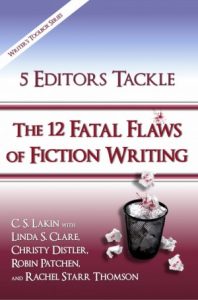7 Quick Ways to Whip Your Novel into Shape
Whipping a novel into shape is a daunting task for many writers. The pain involved with trying to trim down and shape up all those scenes discourages us.
And then there’s the battle with self-esteem and frustration while trying to rework those rebellious passages. Not all that unlike the effort it takes to implement a health-and-fitness regime in our lives.
But there’s good news! Unlike fad diets, there are plenty of easy (painless) ways to help whip your novel in shape.
That’s not to say these tips are a cure-all to major flaws in a novel. But similar to the 30-minutes-a-day-get-in-shape-fast programs, here are some simple things writers can do to tighten sentences, shed unwanted words, and tone and shape the whole “body” of work.
- Eliminate fatty words from your “diet.” Make a list of your weasel words—you know what they are. Those are the words you throw in out of habit. Maybe your editor or critique partner has mentioned them to you. Often they are pesky adverbs like very and just. Or phrases like began to or started to.
Give yourself the challenge to grab a page of your novel at random and see if you can eliminate at least one or two words from every sentence. It may not be possible, but it’s a good exercise. If the word isn’t needed and doesn’t add importance to a sentence, it should go. Some of my weasel words are thought, had, have to, rather, some, and that.
2. Reword passive construction where possible. We hear this a lot. Whether referring to general passive (“The food was eaten by me” instead of “I ate the food”) or present progressive passive (“The food is being served” instead of “the waiters served the food”), most of the time a sentence will be stronger if the passive voice is avoided.
I say most because it can be an obsessive issue with some, who say you should never use passive voice. But there are many instances when passive construction is exactly right for what you want to say.
An easy way to seek and destroy unwanted passive construction is do a “find” for ing, was, is, it was, and there was, to name a few.
3. Break up long paragraphs. Gone are the days of three-page paragraphs. Readers find it easier on the eyes, and a novel’s pacing seems to speed up with shorter paragraphs.
You don’t want to be excessive about this, though, and use an abundance of one-line paragraphs. But if you skim through your novel, no doubt you’ll see many places where you can break up those long paragraphs in appropriate places for smoother reading.
4. Avoid circumlocution. I just love that word, so I had to use it. Don’t use two words when one will do. Don’t use four when three will do. I have a tendency to express things in pairs of words. Sometimes it’s exactly what I need, but other times I am basically being redundant and repetitive (I wrote that on purpose to prove my point, really!). If two adjectives (especially) are similar, pick the best one and toss the other.
5. Ditch the extraneous speech and narrative tags. If the reader knows who is speaking, you don’t need to tell him over and over—especially in a scene with only two characters in dialog.
One author I know said she went through her manuscript and took out as many speech tags as possible and trimmed six thousand words from her novel!
Of course, if you are short on word count, don’t do the opposite. Adding a lot of speech tags will not improve the quality of your book. And remove all those flowery verbs that stick out, such as quizzed, extrapolated, exclaimed, and interjected. Just use said and asked, and maybe an occasional replied or answered. Really.
6. Take out all but the first and last “hads” when referring to the past. If your character is thinking about something in the past (flashback or backstory), you don’t need every sentence in past perfect tense.
Usually the “had” is the giveaway. You might start the flashback with “That day she had gone to the store to get some milk.” The rest of the flashback can be in simple past tense: “She ran into Bob and he said . . . “ When you are done with the flashback sequence, put the last sentence in past perfect to alert the reader you are done with the flashback: “She had decided at that moment never to speak to him again.”
7. And speaking of backstory . . . Yes, the dreaded backstory. But really, do you need it? Take a look at all the places you have backstory and boil down just a few lines of the most important information you feel the reader must know to “get” the story. Then see if you can have a character either think or say these things instead of going into lengthy narrative. Look for any passage that feels like author intrusion or an info dump and find another way to impart the information.
Remember, readers aren’t dumb. They like the challenge of figuring out mysteries. If you explain everything to them, you take their fun away!
By using these seven easy tips, you can help get your novel in shape and trim all those unwanted “pounds” from your pages. It may not do anything to help lower those numbers on your weight scale, but it should help boost your self-esteem and reduce your frustration in your writing time.
And maybe by whipping your novel in shape so quickly and easily, you’ll have more time for that dreaded treadmill staring at you from the corner of your office, or to take walks outside (remember that place?) to clear your head and enjoy God’s creation.
Of course, all these tips and more are covered in the comprehensive book 5 Editors Tackle the 12 Fatal Flaws of Fiction Writing! To be sure you aren’t committing egregious flaws that weaken your writing, read up on all twelve flaws and see how your writing measures up. Get your copy HERE.
What tips help you tighten your writing? Share in the comments.












Thanks to some excellent books I’ve recently read, I’ve learned the trick of how to get inside my character’s head without using the rusty ‘I thought’.
Good tips! I especially watch It is and its cousins, as well as this and that. These aren’t only passives and weasel words, but using them as a replacement for the proper noun may confuse a reader as well. As in:
I love being beside the sea. It does something for my mind when it’s really troubled. It has been choppy and foaming all day and I find that annoying, but otherwise I love it.
Great advice. Thank you. A really good tool I use to find passive words, sticky words, and much more is Prowriting Aid. It is an online editing tool, and you can actually try it for free for short passages of your book. The link is: https://prowritingaid.com/
I’m still having a hard time understanding “sticky words,” but this tool sure helps clean up and trim my story. My biggest mistake is that my characters are always “beginning to” do something, and never just doing them!
Yeah, that’s always been a bit one for me. I used to do a Find for “began to” and “started to” but I think I’ve begun to (lol) resist using those.